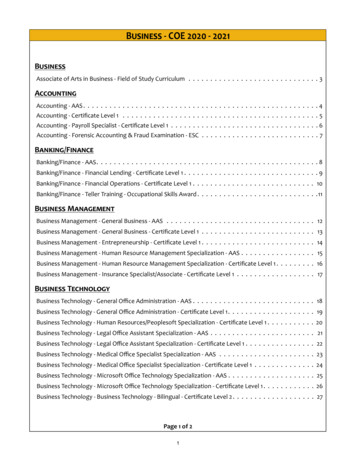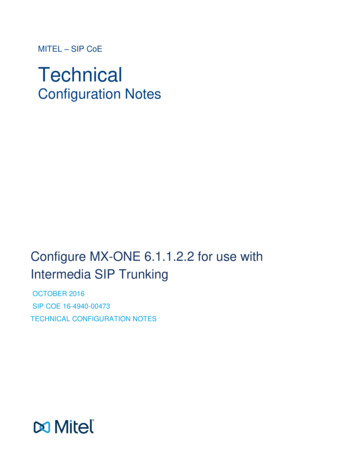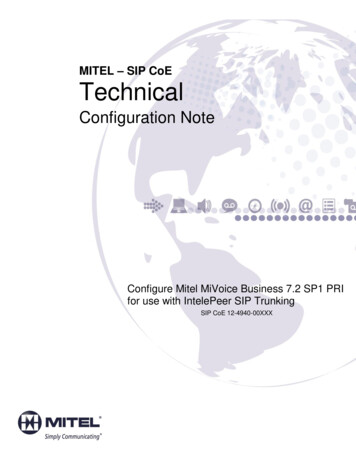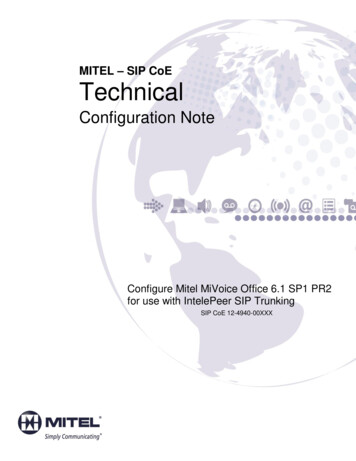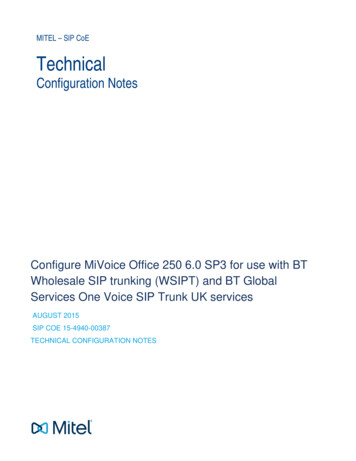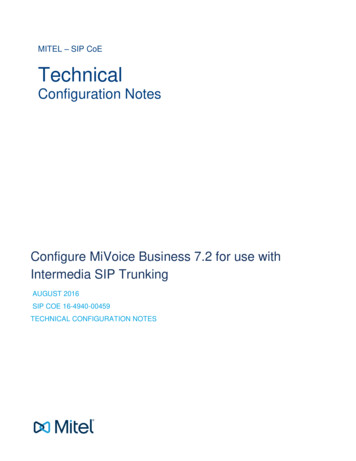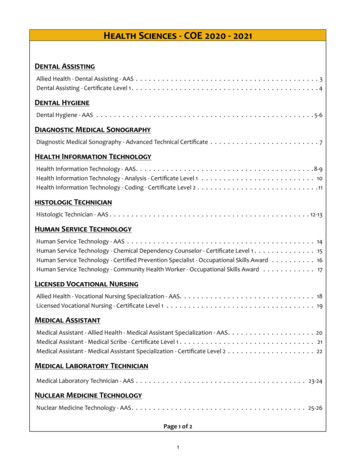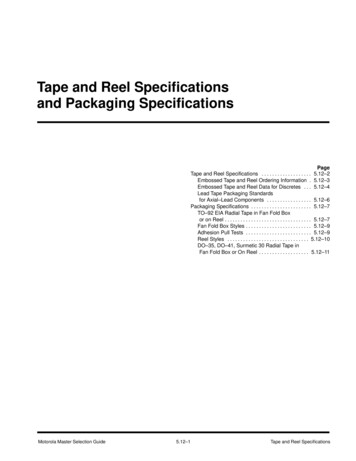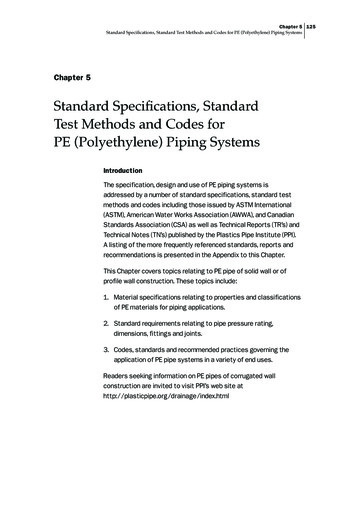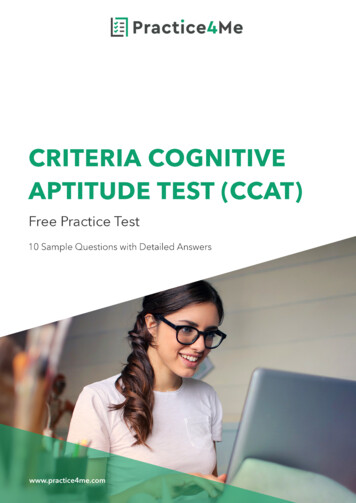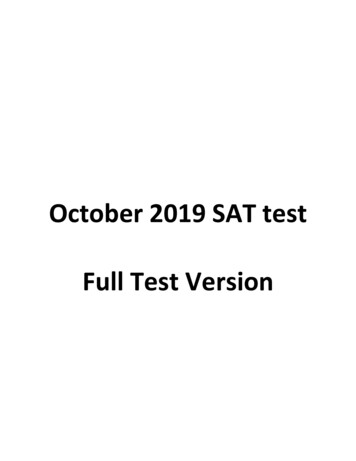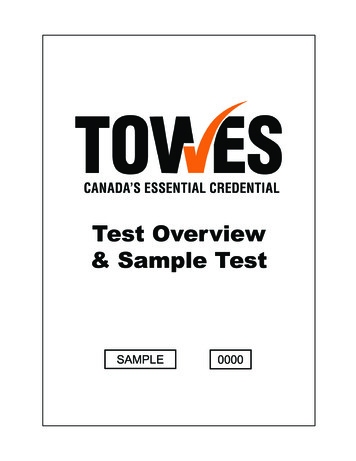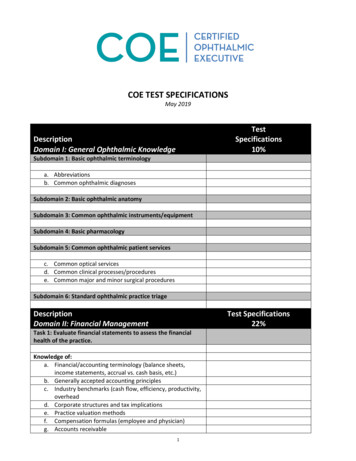
Transcription
COE TEST SPECIFICATIONSMay 2019TestSpecifications10%DescriptionDomain I: General Ophthalmic KnowledgeSubdomain 1: Basic ophthalmic terminologya. Abbreviationsb. Common ophthalmic diagnosesSubdomain 2: Basic ophthalmic anatomySubdomain 3: Common ophthalmic instruments/equipmentSubdomain 4: Basic pharmacologySubdomain 5: Common ophthalmic patient servicesc. Common optical servicesd. Common clinical processes/procedurese. Common major and minor surgical proceduresSubdomain 6: Standard ophthalmic practice triageDescriptionDomain II: Financial ManagementTest Specifications22%Task 1: Evaluate financial statements to assess the financialhealth of the practice.Knowledge of:a. Financial/accounting terminology (balance sheets,income statements, accrual vs. cash basis, etc.)b. Generally accepted accounting principlesc. Industry benchmarks (cash flow, efficiency, productivity,overheadd. Corporate structures and tax implicationse. Practice valuation methodsf. Compensation formulas (employee and physician)g. Accounts receivable1
TestSpecificationsDescriptionh.i.j.k.Accounts payablePayroll taxesBudget preparationBudget analysis (forecasted vs. actual)Task 2: Conduct feasibility analyses to assess return oninvestment.Knowledge of:a. Generally accepted accounting principlesb. Fixed and variable costsc. Feasibility analysis methods (break-even, economic, etc.)Task 3: Evaluate payer contract language and fee schedules todetermine practice participation.Knowledge of:a. Basic contract terminology and principlesb. Fee schedule comparisonsc. Coverage policies (local coverage determinations,national coverage determinations, etc.)d. Payer typese. Utilization patternsTask 4: Evaluate vendor contracts to manage practice needs,overhead expenses, and revenues.Knowledge of:a. Generally accepted accounting principlesb. Basic contract terminology and principlesc. Industry benchmarks (cash flow, efficiency, productivity,overhead)d. Negotiation techniquese. Request for proposal componentsTask 5: Establish accounting and financial controls to protectpractice assets and minimize liability.Knowledge of:a. Generally accepted accounting principlesb. Industry benchmarks (cash flow, efficiency, productivity,overhead)c. Audit trails (checks and balances)d. Internal controls protocols2
DescriptionDomain III: OperationsTest Specificatioins22%Task 1: Coordinate the development, implementation, andmonitoring of the strategic plan to maximize practice potential.Knowledge of:a. Components of the strategic planning process (mission,vision, values, goals, etc.)b. Strategic planning techniques (e.g., StrengthsWeaknesses Opportunities & Threats [SWOT])c. Market research techniques (focus groups, surveys, etc.)d. Project management principlesTask 2: Develop and monitor management reports to evaluatethe operational efficiency of the practice.Knowledge of:a. Report types (inventory, productivity, utilization, etc.)b. Industry benchmarks (cash flow, efficiency, productivity,overhead)Task 3: Develop and implement operational directives, policies,procedures, and training protocols to optimize practiceperformance and ensure quality of care.Knowledge of:a. Satisfaction surveys (employee, patient)b. Industry benchmarks (cash flow, efficiency, productivity,overhead)c. Standards of cared. Fee schedules (usual customary and reasonable charges[UCR], relative value units [RVU])e. Preferred Practice Patternsf. Available training resourcesg. Design and delivery of training and developmentprogramsTask 4: Manage practice real estate, facilities, equipment, andsupplies to provide safe, efficient, and high-quality care.Knowledge of:a. Service contractsb. Inventory controlc. General maintenance and enhancements(leasehold/capital improvements)d. Lease structureTask 5: Develop and manage ancillary service lines (optical,Ambulatory Surgery Center, refractive, real estate, elective,etc.) to align with the strategic plan.3
Knowledge of:a. Industry benchmarks (cash flow, efficiency, productivity,overhead)b. Feasibility analysis methods (break-even, cost-benefit,etc.)c. Regulations and guidelinesd. Alternative and/or elective servicese. Marketing strategies (internal and external)Task 6: Determine staffing needs to ensure practiceproductivity and efficiency.Knowledge of:a. Industry benchmarks (efficiency, productivity, overhead)b. Needs assessmentTask 7: Develop and implement marketing plans to support andenhance business lines.Knowledge of:a. Industry benchmarks (cash flow, efficiency, productivity,overhead)b. Marketing terminologyc. Marketing strategies (internal and external)d. Regulatory guidelines for advertising and promotione. Lead trackingf. Return on investment4
DescriptionDomain IV: Information Technology ManagementTest Specifications12%Task 1: Implement and manage information systems to meettechnology needs and comply with regulatory requirementsand/or guidelines.Knowledge of:a. Applicable laws, regulations, and guidelines (e.g.,“meaningful use”)b. Basic network infrastructure (cloud-based vs. on-siteservers, wired vs. wireless network, etc.)c. Basic hardware components (servers, workstations, etc.)d. Electronic health record systemse. Practice management systemsf. Electronic billing technologyg. Document storage and retentionh. Image managementi. Ophthalmic equipment interfacingTask 2: Perform information technology risk analyses to ensurethe confidentiality, integrity, and availability of practice data.Knowledge of:a. Network securityb. Storage solutionsc. Security risk analysisd. Disaster recovery planDescriptionDomain V: Human ResourcesTest Specifications18%Task 1: Develop and modify personnel policies to establishexpectations for professional conduct.Knowledge of:a. Applicable laws, regulations, and guidelinesb. Personnel policy components (workplace conduct, attire,social media, etc.)Task 2: Educate, coach, reward, and/or discipline staff toensure compliance with personnel policies.Knowledge of:a. Applicable laws, regulations, and guidelinesb. Reward/discipline techniques (including properdocumentation)c. Educational/coaching strategiesTask 3: Develop and oversee programs to provide fair andcompetitive compensation packages.5
Knowledge of:a. Applicable laws, regulations, and guidelinesb. Industry benchmarks (cash flow, efficiency, productivity,overhead)c. Benefits package components (health insurance,retirement, etc.)d. Salary administration (cost-of-living raise, merit-basedraise, bonus)e. Employment classifications (exempt/non-exempt,contract, locum tenens, etc.)f. Employee incentive programs (monetary and nonmonetary)Task 4: Recruit, retain, and terminate staff to meetorganizational staffing needs.Knowledge of:a. Applicable laws, regulations, and guidelinesb. Talent acquisition strategiesc. Job description componentsd. Employee retention strategiese. At-will vs. right-to-work statesTask 5: Conduct evaluations to enhance employee and practiceperformance.Knowledge of:a. Types and purposes of performance reviewsb. Tools for assessing employee performancec. Evaluation strategies (timing, context)6
DescriptionDomain VI: Risk Management & RegulatoryComplianceTask 1: Develop programs to ensure compliance withgovernmental regulations and guidelines.Knowledge of:a. U.S. Office of Inspector General Compliance Programcomponentsb. Provider Self-disclosure Protocolc. OSHAd. FMLAe. HIPAA/HITECHf. ADAg. Wage and labor laws (e.g., FLSA, EEOC)h. Insurance regulations (e.g., ERISA, COBRA, AffordableCare Act)i. False Claims Actj. Title VII (Civil Rights Act)k. Stark and anti-kickback statutesl. Anti-trust statutesm. Coding and documentationn. Billing (covered, non-covered)o. Co-managementp. Audit protocolsq. Applicable laws, regulations, and guidelinesTask 2: Mitigate legal liability (regulatory and negligence) tominimize financial losses.Knowledge of:a. Applicable laws, regulations, and guidelinesb. General business liability insurance (property,regulatory, cyber, etc.)c. Medical malpractice insuranced. Workers’ compensation insurancee. Quality assurance programs7Test Specifications16%
a. Report types (inventory, productivity, utilization, etc.) b. Industry benchmarks (cash flow, efficiency, productivity, overhead) Task 3: Develop and implement operational directives, policies, procedures, and training protocols to optimize practice performance and ensure quality of
